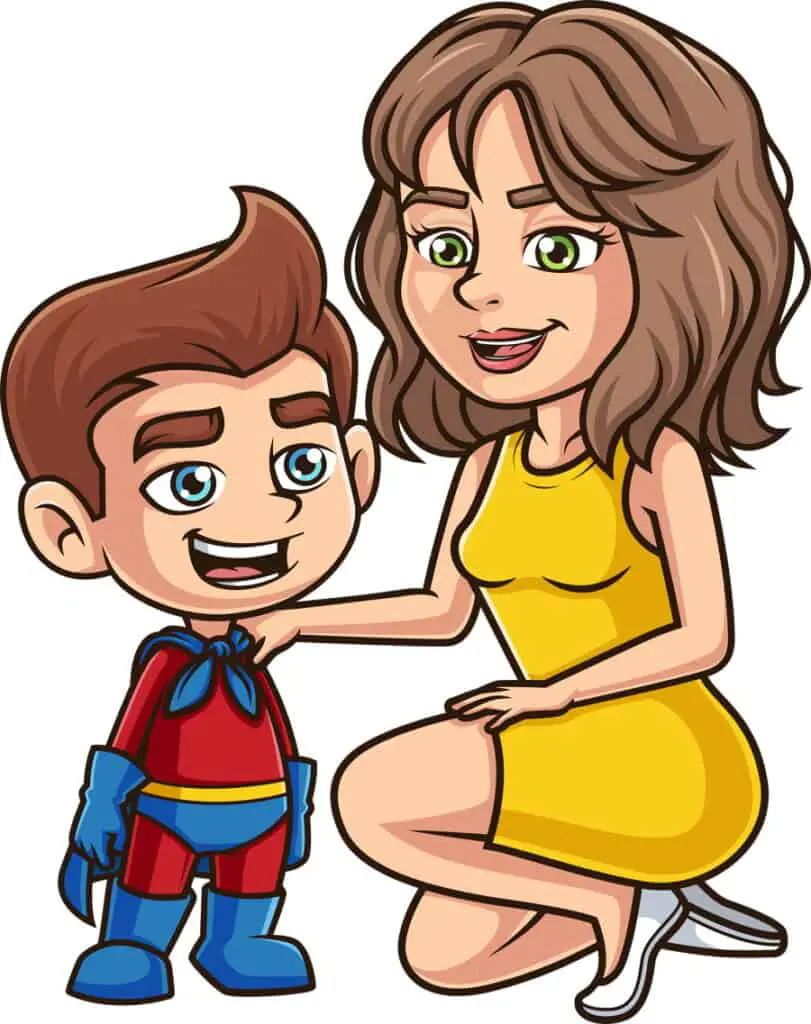
Parents (and other connected adults) love to bring fun and laughter to their littles, but what about children with ASD who don’t have typical reactions to humor? How can you make kids with autism the laugh?
You can make children with autism laugh by: using humor focusing on their interests; jokes that are simplified; and repeating approaches to make humor familiar. Though these three ways will likely make all children laugh, they are particularly successful with children on the autism spectrum.
As a former public school teacher, I’ve taught several children somewhere on the autism spectrum. As well, as a mom of four, I have experience on a personal level. One of our children was diagnosed autistic early on. Not only have I learned best practices for communicating and teaching children with ASD, but also how to help them with humor (and other practical living).
I am happy to share my experiences on what makes autistic children laugh!
Contents
For a little background, let’s address what it means for a child to be autistic or diagnosed with Autism Spectrum Disorder (ASD).
The American Psychiatric Association is credited with the creation of a guide for diagnosing ASD called the Diagnostic and Statistical Manual of Mental Disorders (DSM-5). In it, people with ASD are said to have challenges with communication and social interaction; restrictive, targeted interests; behavior often repetitive and extreme; and limitations on their ability to function in school, work, and other areas of life typical for most people.
As a mom of a child with ASD, I can easily relate to the information provided by Dr. Horowitz and the manual from the American Psychiatric Association.
For example, I’ve seen in my son the problems with making eye contact, as well as how he often talks at great length about a favorite subject without noticing (or caring) if anyone else interested or even around to hear. His facial expressions and tone don’t often fit the situation or context he’s in, either. He’s extremely sensitivity to small sounds, lights, and is hyper-focused on changes in routine, too.
All of these things greatly affect our son’s life, and ours by extension. He’s not able to successfully go to a regular school, even with accommodations and modifications by an Individualized Education Plan (IEP).
And under the very best of circumstances, Ethan still requires supports to limit agitation and frustration from all those around him. And in a show of agreement, recent research expounds the toll ASD takes on the whole family.
With all this said, it’s even more important for families living with ASD to have outlets for humor, laughter, and fun!
Make An Autistic Child Laugh By Connecting with their Interests

You can make an autistic child laugh by using humor that connects with their interests. Kids on the spectrum commonly have extreme interests or heightened focus on certain things.
For example, children with ASD might only want to eat green foods, use the blue crayon, or play with toys that roll.
Find Jokes on Their Interests
Our son was particularly drawn to red things. If he and his twin were given new clothes or toys, he’d immediately grab ‘the red one’ because that already belonged to him, in his myopic mind’s judgment. Over time, we were able to expand his interests beyond ‘red’ and to more than one thing, but he’s still prone to ‘targeted likes.’ At the moment, we are all well aware that he likes dragons, wolves, Pokémon, and SpongeBob.
Now many of you might say, we’ll that’s typical of most kids…they all go through phases, right. I remember my Bon Jovi days after all! Well, yes, but again, for a kid on the spectrum, it’s extreme with tunnel-vision. But you can use this to your advantage when trying to make them laugh!
This means you can collect jokes on what they like.
For Ethan, he really likes jokes that have to do with dragons because he really likes dragons. It’s hard to get him to read any other kind of book without making it a ‘have to’, because he likes to read books with dragons so much! So if we come across a joke with dragons, we know that’s for Ethan.
Many autistic kids will watch a tv show or film over and over. You can make jokes that connect with that. If your child loves the Disney cartoon, Cars, you can look up jokes on cars. (You can purchase Cars from Amazon.)
Now for it to be successful, be sure to point out the connection for them. What may seem obvious to us is often overlooked, or not easily recognizable, for kids with autism. And be explicit when you do.
For example, say, “I know you like Cars, the movie. Here’s a joke about cars. Because you like the movie, you will probably like this joke.”
*Tell the joke clearly, and slowly. Pausing when the punchline comes up.*
You should also explain why the joke is funny in order to help your child with ASD understand the humor better.
Say, “this joke is funny because…“
Then, I recommend telling the joke again. Maybe even ask your child to tell the joke to you or another family member after that, and later on as well. As you’ll learn in another section, repetition is important for children with autism to grasp humor.
Change the Joke to What Interests Them
Just because you can’t find jokes on their interest or humorous toys, movies, etc…you can make adjustments.
This means we can adapt jokes for his particular interest. If we hear a joke that features a panda bear, we can alter it to dragons instead…that is, if the punchline isn’t connected to being a panda bear.
It might not come naturally, but you can even make it a project with your child. Often laughter comes just from being silly, so give it a try. Your child might surprise you!
Autistic Children Will Laugh At Simple Humor
Often times it’s the simplest, cheesiest joke that will make your kid with ASD laugh out loud. Your child may have an advanced vocabulary and skills in math or science that are above others his or her age, but in humor, kids with ASD are usually behind their peers.
Kids with ASD have difficulty with hidden meanings behind words; subtle inferences; and inflections in conversation, all of which make understanding the humor in jokes difficult for them. As well, the very act of laughing is different in kids with ASD according to this study from the National Library of Medicine. This doesn’t mean it’s impossible; on the contrary, for most, it’s not. But instead, it means they need help in this area.
Thus, making jokes and any attempts at humor should be clear, obvious, and simple.
Dad Jokes Make Autistic Children Laugh

Dad jokes are a good attempt for making children with autism laugh. But let’s make sure we know just what a ‘dad joke’ is.
dad joke: a wholesome joke of the type said to be told by fathers with a punchline that is often an obvious or predictable pun or play on words and usually judged to be endearingly corny or unfunny (Merriam-Webster)
Just reading the definition should make it clear why dad jokes are a good choice for children on the spectrum. Dad jokes are pretty obvious in their humor and this is often the best kind of joke for those who struggle with double meanings or punchlines that rely more on irony or tone.
Here are a few easy dad jokes you can try (Source: Parents.com):
- Why did the math problem look so sad? Because of all its problems.
- What did the slow tomato say to the others? Don’t worry; I’ll ketchup.
- Why did the coach go to the bank? To get his quarter back.
- Why don’t eggs tell jokes? They’d crack each other up.
Slapstick Humor: Pros and Cons
Slapstick humor is a good way to make an autistic child laugh. It’s another obvious, up-front attempt at humor, which works best for ASD.
slapstick: comedy stressing farce and horseplay (Merriam-Webster)
Children with ASD will often laugh out loud inappropriately when someone falls or breaks something. Normally, we’d first make sure the person is not hurt or that the item isn’t valuable, and then, maybe we’d laugh. However, social norms and reading a person’s body language and facial expressions properly are not typical for someone with ASD. However, this same impulsive reaction can be harnessed for slapstick humor.
Using slapstick is also a good tool for teaching appropriate reactions, i.e. when it’s acceptable to laugh and when it’s not.
The problem with slapstick humor is that kids with ASD might try to reenact the performances and that could be a potential hazard. Kids with ASD sometimes don’t see the line between reality and fantasy and may inadvertently cause harm to themselves and others.
For example, Mr. Bean falling down the stairs is funny, but your child falling (or pushing a sibling or pet) down the stairs is not. When watching slapstick humor or using it at home, you’ll want to discuss the potentials for problems, too.
Autistic Children Laugh At Familiar Jokes
Using jokes or humorous tactics over and over is a way to make an autistic child laugh. Even if they didn’t get the joke the first time, eventually they can learn to find it funny (unlike others who would be increasingly annoyed by you trying the same failed joke again and again!).
By repeating the humor, kids with ASD become familiar with it and thus, learn to mimic the correct response or actually understand what makes it funny, or some combination of the two.
Good ways to pair repetition with humor is with patterned jokes like Knock Knock jokes and with using the same joke or humorous manner in the same context regularly. Read on to learn more about applying these methods.
Pattern Jokes Work Well for Autistic Kids
It’s probably no surprise to anyone familiar with ASD that kids on the spectrum like patterns. Patterns can be anything from lining up their cars in a row to following the same routines daily.
Knock Knock Jokes
Knock Knock jokes are a great tool to teaching humor to your children with ASD and to make them laugh in the process. Knock Knock jokes work well because they incorporate the same lines and kids know what to expect.
They’re also really good to modify or tweak specifically for your child (Remember the other way I mentioned for making kids with ASD laugh is to focus on their interests. You can do that with Knock Knock jokes.)
We have several articles on the site loaded with Knock Knock jokes to help you out. These jokes are a great start to your Knock Knock joke ‘toolbox’ (that’s teacher lingo for your figurative materials to use, by the way.)
Some examples are:
- Peanut Butter and Jelly Knock Knock jokes
- Knock jokes on Candy Canes
- Knock Knock jokes about cats and dogs

Category Jokes
Category jokes are jokes about a singular topic or thing. For example, our jokes are delineated in this way.
Our joke categories are:
Maybe you pick one area like animals and every day at breakfast you tell an animal joke. Your child will come to expect this and will likely learn to respond favorably by laughing. Perhaps eventually, your child will even want to add to the jokes. This will be easier for him or her to do because you focused on one particular category-by sharing a joke about an animal.
Tell Jokes the Same Way, Same Time (and Repeat)

I alluded to this above; it will be easier to make your kid with ASD laugh when you use humor regularly and consistently at the same time, and if possible, within the same context. Now this might seem very structured, and yes, I agree it is. But it’s helpful for your child and it’s not complicated.
What does this mean or look like? In my example in the previous section, it meant telling an animal joke at breakfast. It could also look like telling a food joke at bedtime.
For us, it’s my husband saying ‘Ethan, we done done it’ in a red-neck voice every evening after saying the rosary as a family. Ethan has come to expect this and though he’s not necessarily laughing out loud, he’s smiling and even mimicking in his own red-neck voice from time to time. (My husband considers himself a red-neck transplant, so that’s part of the humorous connection.)
Telling the joke or using a humorous phrase in the same way or in the same context repeatedly helps your child become familiar with it and find it funny. Kids with ASD don’t respond well to changes in their routine or things they aren’t used to, so it is understandable that jokes can be a problem. Though most of us would get bored with the same joke, a child with ASD will not.
What Doesn’t Make An Autistic Child Laugh
There are some common tactics used for the sake of humor and provoking laughter that work for most kids that won’t work for kids with autism or on the spectrum. I’ll elaborate on a few.
- Tickling Tickling does not work as a way to make kids with ASD laugh. Kids with ASD typically don’t like to be touched. They have heightened sense of touch and even the smallest physical gesture can produce strong negative reactions. I know three of our kids loved to be tickled when little and judging by the popularity of Tickle Me Elmo (Amazon linked) back in the 90s, it seems they weren’t alone. However, our son with ASD did not. Laughter was never a result of tickling for him!
- Playful Bugging For lack of knowing a better way to explain, I call it playful bugging when you are slightly annoying a child to get them to laugh. Let me explain so that I don’t seem like an ogre! Example: Your child wants you to hand them something so you pretend to, only to move it out of reach just slightly and repeat for a few times. This ends up with both you and your child smiling and laughing. Now of course, you’re only doing this a few times and then you give them the item! But children with ASD rarely see the humor in playful bugging, and just feel bugged instead!
- Copycatting Copycatting your child is when you repeat what your child says or does. You might think of this as ‘parroting’, also. Normally, children will find this tactic funny and start ‘copycatting’ you back! Like with playful bugging, this assumes you don’t take it too far. Nothing is funny if you do that! Keep in mind the extent of copying/parroting (for it to be funny) is tied to age. What’s appropriate for an 8 year old is not typical for a 3 year old, so modify accordingly. However, this tactic for humor is difficult for kids with ASD to understand and once again, they find it more annoying than funny.
- Sarcasm This humorous tactic is mostly reserved for older kids (or younger kids with a keen sense of humor) because it requires the cognitive ability for understanding double meanings, irony, and larger vocabulary. It’s not that children with ASD aren’t smart enough to get it; rather it’s the lack of being able to accurately perceive social norms and mores is what causes sarcasm to elude them.
Disclaimer: Now even though the above tactics are challenging for children with ASD, it’s not to say that they won’t work for a few or that they can’t be taught. Exceptions are always possible.
I know our son, Ethan, has been taught several sarcastic expressions and he even throws them back at us from time to time. This has been achievable for a couple of reasons: We have explained the reasoning behind a few of the retorts and another is that we’ve included repetition in using them, that is, repeating the same sarcastic phrases or expressions many times within the same context.
And in full disclosure, Ethan still doesn’t necessarily get the humor; he just understands that it’s meant to be humorous. And more importantly, he appreciates being included this way.
The Punchline for How To Make An Autistic Child Laugh
Even though it should already be understood, I’ll say it to be perfectly clear: all kids are different and you know your children better than anyone else, so this article should be taken as suggestions based on my teacher and mom experiences with children with ASD. Try them out; tweak what needs tweaking and make it work for you.
To recap, it’s definitely possible to make your autistic child laugh. However, it won’t be the same as with other children. You will have more success in making your child with autism laugh if you:
- use humor that focuses on their interests
- make sure the jokes are simple and clear
- repeat your approaches so the humor is familiar
I hope you’ve enjoyed learning from my experiences!
For further study, I recommend:
